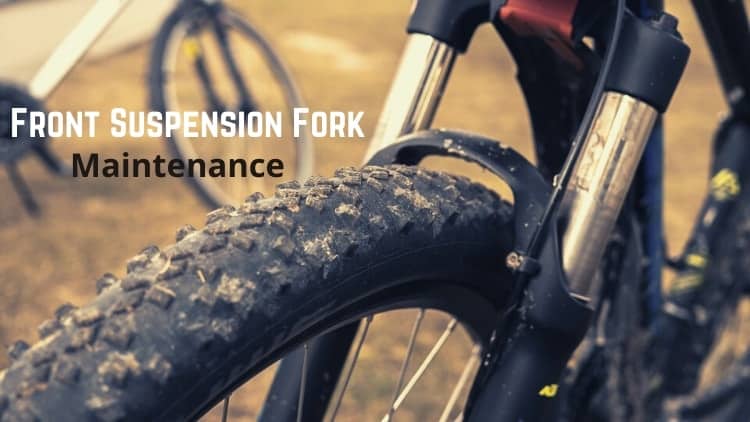When you first start Mountain Biking, it can be a little surprising how expensive things are.
From Carbon bike frames to hydraulic Dropper Posts, keeping up with the latest trends can take a toll on your wallet.
This is why we stress the importance of Bike Maintenance.
Luckily, Mountain Bike parts are built to last, and coupled with frequent cleaning and maintenance, you can really extend the life of your Mountain Bike and its moving parts.
One of the most important parts to maintain is the front suspension fork.
Often being the first thing in contact with the ground and obstacles, they can really take a beating over time.
And if you ever need to replace or upgrade, you could be looking at a few hundred to thousand dollars worth of investment.
So make sure you stay on top of the maintenance, and increase the life of your Front Forks.
To help you on your way, we created this guide with everything you need to maintain the front fork on your Mountain Bike.
Fortunately, your Front Suspension Forks are relatively self-sustaining, and as long as you’re keeping them clean and taking them in for yearly service, you shouldn’t have any problems. But you still need to know what keeps them working well, so keep reading to learn how to maintain them.
Clean
Just about every Maintenance tip for your Bike starts with a good cleaning, and Front Fork Maintenance is no different.
Keeping your forks clean is one of the best ways to extend the life of your forks and will also keep them running better overall.
Dirt and grime can be really tough on your Bike parts, causing them to lose performance over time, even failing completely.
This is why manufacturers stress the importance of lubrication and cleaning.
The goal is to keep the dirt out and the oil in.
If you can balance this, you’ll get the most out of your Bike and its components.
You can clean your front forks with water but avoid spraying directly on the seals, so you don’t get any water inside the fork. If you do decide to use a high-powered spray, make sure you turn the bike upside down. Remove all the dirt and grime from the Fork Stanchions and from around the Fork Seals.
Once you’ve made sure everything is clean, it’s time to move on to the next step.
Inspect the Fork Stanchions
Now that your Forks are clean, it’s time to check one of the most vital parts – The Fork Stanchions.
It can be hard to spot any issues with your Fork Stanchions, when they’re clean, it’s a lot easier to spot any damage.
You’re looking for scratches, dents, wear, or play in the bushings.
All of these are signs of something serious going on with your Forks and spotting them early can help you avoid costly repair.
After you visually inspect the forks for scratches or damage, hold your front brake and rock your Bike backward and forward. If you notice any “play” in the bushings around the stanchions, it’s time to take your Bike in for a service.
It’s important to note that beginner rider shouldn’t service their Forks if they’re not confident. Front Fork servicing is usually completed by a Bike Mechanic or similar.
Lubricate
Now that you have your Forks cleaned, you may think it’s time for lubrication.
But don’t get too ahead of yourself, you most likely don’t need to lubricate your Forks.
In fact, the lubrication within the Lower Forks should be enough to keep everything lubricated. So there is no need to lubricate the Stanchions or the Seals.
The Lower Forks contain a lot of components that work to keep the Forks well-oiled and dirt-repellent.
This comes down to a series of Bushings and Foam rings that seal the system from dirt while keeping the oil in.
Make sure you take your Forks in yearly for Maintenance and maintain at least 5 to 10 ml of oil in the Lower Fork.
Combine this with regular cleaning, and you shouldn’t run into any trouble.
Service the Lower Forks
Eventually, you will have to service your Lower Forks.
Over time, you lose oil, bushings wear, and performance is impacted.
Taking your Bike in for a Lower Fork Service or servicing them yourself is an essential step in Bike Maintenance.
As mentioned before, this type of service is best left to the professionals, however, if you feel you’re up to the task, you can try it yourself.
For those DIYers, find the appropriate manual for your Forks through the links below and then check out the video on Lower Fork Maintenance.
Bomber Fork Maintenance
You can also search Google or YouTube for specific Fork tutorials.
Check out this video on Lower Fork Service below:
Make sure you watch the entire video before servicing your own Forks, as this will really determine if you’re up to the task.
Tips for Maintaining Front Suspension Fork
Along with the standard Maintenance tips, there are a few extra tips for protecting your Front Forks.
1. Mudguards – Mudguards are great at helping you keep the dirt and grime out of your Forks and they’re pretty cheap. If you ever have trouble with mud on your bike in general, think about getting a pair.
2. Prevent Cable Rub – Try to clean up the cables around your cockpit so they don’t rub against your forks and cause scuffs and scratches.
3. Service the Lower Forks – Try to get a yearly service on your Front Forks.
And just like everything else, try to keep your Bike clean!
Conclusion
In conclusion, your Front Forks are one of the most expensive parts on your Bike.
But with a little cleaning, they are one of the most self-sustaining parts on your Bike.
Keep them clean and keep an eye out for any issues and you should be good for years to come.
Safe riding and have fun!

